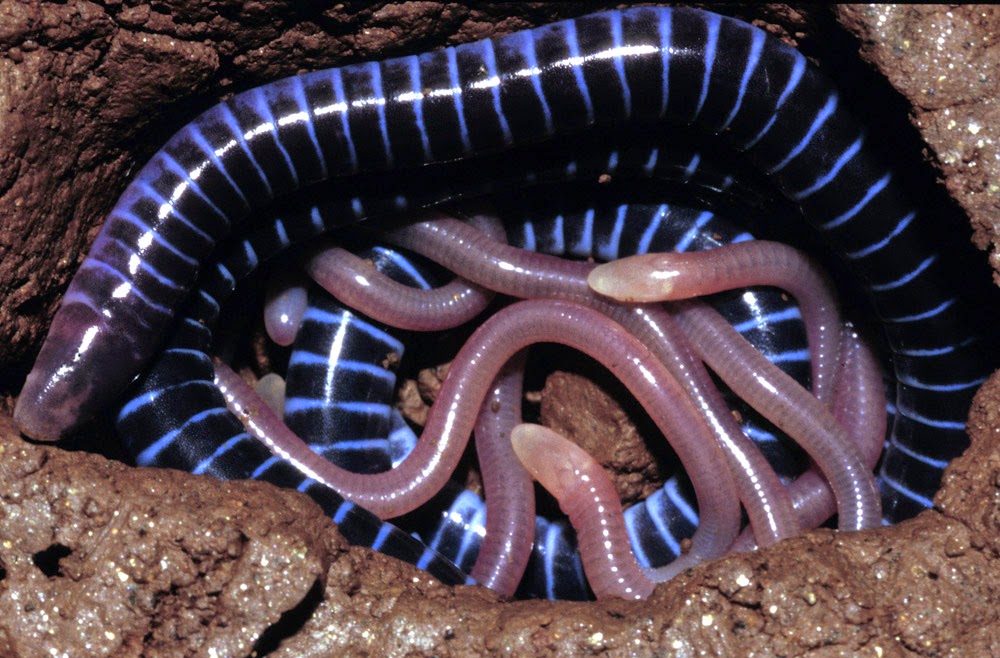Most people, if shown the image above, would call the creature a worm. They would be wrong. Nor is it a snake, or even a strange sort of eel. It's actually a strange amphibian called a Caecilian. These weird creatures aren't very well known amongst the general public, and spend most of their time burrowing underground. They can be found in several tropical regions of the globe.
Their name comes from from the Latin 'caecus', meaning 'blind'. This is actually wrong, they aren't blind, but their vision is limited to dark-light perception.
They have lots of folds of skin on their body called annuli, giving a segmented appearance - rather like a worm. All species of Caecilians have tiny tentacles on their head, midway between their nostrils and eyes. It is thought that these tentacles are secondary oflactory (smell) organs.
A close up a Caecilian head, showing the small tentacles.
Little is known about the diet of these bizarre creatures. In captivity they can easily be fed completely on earthworms, and it is thought that these make up the main food in the wild. They probably will also eat other small invertebrates. To crunch on these insect snacks, they have surprisingly prominent teeth. I think that their heads look almost shark-like when you see their large teeth.
In this image you can see the Caecilian's teeth.
Caecilians aren't just strange on the outside. If you were to cut open one of these amphibians, you would see that one of their lungs is tiny in comparison to the other. This is an adaption to having a serpentine shape, and it is a feature shared with snakes. There is even 2 Caecilian species that completely lack lungs, and absorb oxygen through their skin!
Though most are burrowers, there are also some that spend most of their time in water, like eels.
Most species give birth to live young, but a few species lay eggs in underground burrows. The female will wrap around the clump of eggs and guard them.
A Caecilian female guards her eggs.
In some egg-laying species, the juveniles are fully developed as soon as they emerge from the egg. Others go through a semi-aquatic larval stage that spends most of the time around water.
One species goes to great lengths to ensure the survival of their young. The female will stay with her juveniles in a burrow, and she feeds them on her outer layer of skin! The babies have large teeth so that they can peel the skin away. When the outer layer of skin is gone, the babies will have to wait 3 days (the time it takes for skin to grow back) until they can have another nutritious snack. And you thought looking after your kids was hard! Imagine having to feed your children your own skin!
A female Caecilian with her babies.
Caecilians first evolved in the time of the dinosaurs! The very first caecilian known is Eocaecilia, which lived in the Jurassic period, around 200 million years ago. It had small legs and well-developed eyes.
A reconstruction of Eocaecilia.
All is not well in the world of caecilians though. Amphibians can be infected with a particular type of fungus, and this fungus can cause diseases deadly to amphibians. Frogs, toads, newts, and salamanders are all threatened. Until recently, it was thought that caecilians were impervious to this fungus. However, a new study shows that caecilians can be infected. It seems that the lives of caecilians and their wonderful amphibian relatives are hanging in the balance.Scientists are researching the fungus more, in the hope that with more knowledge we may be able to save these incredible creatures. There is still hope for the amphibians.
I hope that you've enjoyed this post - I know that I have certainly enjoyed writing it. Caecilians are truly amazing creatures.
Until next time, keep on the wild side!






Beyond Cool !!!
ReplyDeleteBeyond Cool !!!
ReplyDeleteThanks! Why not take a look at my other posts, I'm sure you'll find other fascinating creatures!
ReplyDelete